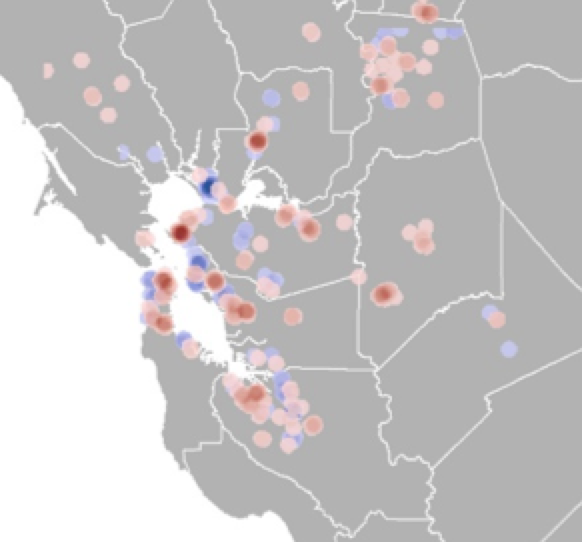Spatial pattern of BMI among adults in Northern California
 Tuesday, December 9, 2014 at 8:41AM
Tuesday, December 9, 2014 at 8:41AM Laraia, B. A., S. D. Blanchard, A. J. Karter, J. C. Jones-Smith, M. Warton, E. Kersten, M. Jerrett, H. H. Moffet, N. Adler, D. Schillinger, and M. Kelly. 2014. Spatial pattern of Body Mass Index among adults in the Diabetes Study of Northern California (DISTANCE). International Journal of Health Geographics 13:48 doi:10.1186/1476-072X-13-48
 clustering of high and low BMIThe role that environmental factors, such as neighborhood socioeconomics, food, and physical environment, play in the risk of obesity and chronic diseases is not well quantified. Understanding how spatial distribution of disease risk factors overlap with that of environmental (contextual) characteristics may inform health interventions and policies aimed at reducing the environment risk factors. We evaluated the extent to which spatial clustering of extreme body mass index (BMI) values among a large sample of adults with diabetes was explained by individual characteristics and contextual factors. We quantified spatial clustering of BMI among 15,854 adults with diabetes from the Diabetes Study of Northern California (DISTANCE) cohort using the Global and Local Moran's I spatial statistic. We found substantial clustering of extreme high and low BMI values in Northern California among adults with diabetes. Individual characteristics explained somewhat more of clustering of the BMI values than did neighborhood characteristics. These findings, although cross-sectional, may suggest that selection into neighborhoods as the primary explanation of why individuals with extreme BMI values live close to one another. Further studies are needed to assess causes of extreme BMI clustering, and to identify any community level role to influence behavior change. Journal link.
clustering of high and low BMIThe role that environmental factors, such as neighborhood socioeconomics, food, and physical environment, play in the risk of obesity and chronic diseases is not well quantified. Understanding how spatial distribution of disease risk factors overlap with that of environmental (contextual) characteristics may inform health interventions and policies aimed at reducing the environment risk factors. We evaluated the extent to which spatial clustering of extreme body mass index (BMI) values among a large sample of adults with diabetes was explained by individual characteristics and contextual factors. We quantified spatial clustering of BMI among 15,854 adults with diabetes from the Diabetes Study of Northern California (DISTANCE) cohort using the Global and Local Moran's I spatial statistic. We found substantial clustering of extreme high and low BMI values in Northern California among adults with diabetes. Individual characteristics explained somewhat more of clustering of the BMI values than did neighborhood characteristics. These findings, although cross-sectional, may suggest that selection into neighborhoods as the primary explanation of why individuals with extreme BMI values live close to one another. Further studies are needed to assess causes of extreme BMI clustering, and to identify any community level role to influence behavior change. Journal link.
Key Words: body mass index, diabetes, spatial clustering, Moran’s I, spatial autocorrelation, neighborhood characteristics, geographical epidemiology
 gis,
gis,  health,
health,  open access,
open access,  pattern,
pattern,  spatial analysis
spatial analysis